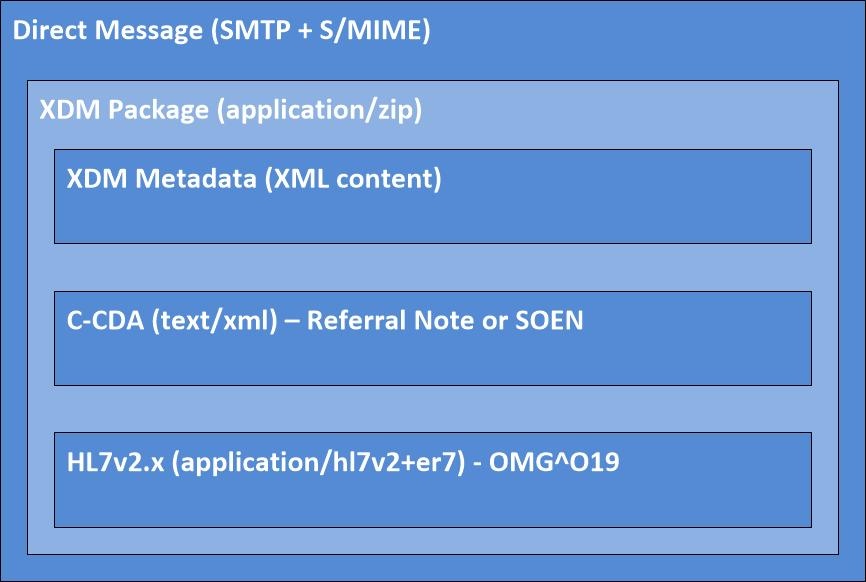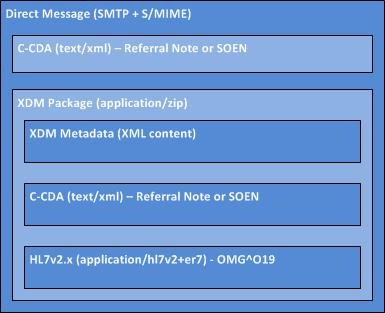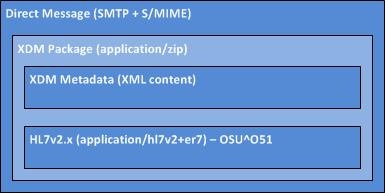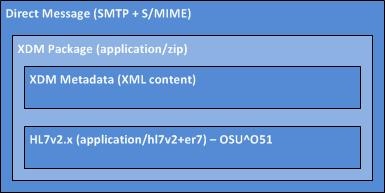...
The format of the request will be an XDM package (containing the HL7 V2 Order, C-CDA and XD metadata), sent as an attachment of a Direct Protocol message. Per the summary above, 360X does not specify the C-CDA nor its contents, but to qualify for MU objectives, CMS and ONC require the C-CDA contain the Common MU data Set (2014 Edition) or the Common Clinical Data Set (CCDS) (2015 Edition) and be of the specified version. The document template used may be a CCD Summary of Episode Note (where industry has indicated that this is the "best fit" doc template for that data set) or a Referral Note template; both templates are allowed under the Meaningful Use program and 360X. 
| HTML |
|---|
<div class="clr-fig-caption">Figure 7.1: 360X compliant transport protocol and referral request payload</div> |
Note that in the current state of industry interoperability, many application providers support a C-CDA alone transmitted using Direct. If an application needs to communicate to both 360X compliant applications and applications using exiting capabilities, a single message might be constructed as follows so as to avoid crafting different messages for different recipient capabilities.
| HTML |
|---|
<div class="clr-fig-caption">Figure 7.2: 360X compliant application providing a single message to accommodate both 360X compliant and legacy recipients</div> |
...
The 360X referral request package SHALL contain a C-CDA document for the related clinical information. The C-CDA is represented as a distinct document entry object in the XDM metadata, and it shall be present as a separate file within the XDM structure, with a file extension of .xml.The following spreadsheet contains the analysis of available C-CDA document and section templates:
...
- the submission set
- the HL7 V2 order document entry of the payload
- the C-CDA document entry of the payload
7.1.4.1 Submission Set
...
| Attribute | Purpose within 360X | Required (Source of Requirement) | Corresponding HL7 Field/Component/Subcomponent |
| author | If supplied, MUST indicate the document's (order) author, which may be different from the message sender. For the order, this is the clinician who is requesting the referral. | >R2
(XDR and XDM for Direct Messaging) | Ordering Provider in ORC-12 |
| classCode | Identifies the specific document type, in this case an HL7 V2 Order.
See also typeCode which further refines the class definition and should not be ambiguous | R
(360X)
(R2 XDR and XDM for Direct Messaging) | Message Type in MSH-9.1 (OMG) |
| confidentialityCode | Identifies the confidentiality defined for the order.
Implementations SHOULD NOT use codes that reveal the specific trigger causes of confidentiality (e.g., ETH, HIV, PSY, SDV) | R2
(XDR and XDM for Direct Messaging) | Confidentiality Code in ORC-28
Implementations SHOULD constrain to values that do not reflect the cause of confidentiality such as:
V Very restricted
R Restricted
U Usual control |
| creationTime | Defines the creation time of the message (vs. the order) | R2
(XDR and XDM for Direct Messaging) | Date/Time of Message in MSH-7 |
| entryUUID | The identifier used for referencing the Document Entry object within the metadata | R
(XDR and XDM for Direct Messaging) | N/A
|
| eventCodeList | This list of codes represents the main clinical acts which does not conflict with the class and type codes. In this case, extends the document type (classCode=OMG, type=O19) to define the specific service requested. | O
(IHE XDR) | When the document entry is the C-CDA document, which contains the clinical information of the Referral Outcome (e.g. the consultation note), the eventCodeList should contain the appropriate ECQM SNOMED codes for closed loop referral. Universal Service Identifier in OBR-4, CWE_2.1
Where XDR classification scheme is name of coding system in CWE_2.3 |
| formatCode | Globally unique identifier specifying the format of the document (referral request/order) to allow systems to determine if / how to process.
For 360X can be formed from
MSH-9 Message Type
MSH-12 Version ID
MSH-21 MessageProfileIdentifier | R
(360X) | OMG^O19_2.5.1_360XReferralRequest |
| healthcareFacilityTypeCode | See also practice setting type. This code represents the type of organizational setting of the clinical encounter during which the documented act occurred. Note that in context of 360X, this is the facility type of the Referral Request Initiator. | R2
(XDR and XDM for Direct) | Should be derived from / mapped to the information in ORC-21 through 24 | | |
| languageCode | Specifies the language of the document (order / referral request) | R2
(XDR and XDM for Direct) | Principal Language of Message in MSH-19 |
| mimeType | The MIME type of the document | R
(XDR and XDM for Direct Messaging) | x-application/hl7-v2+er7 |
| patientId | See also sourcePatientID.
patient ID MUST be the same as the patientID in the submission set (which, not does not include the sourcePatientID) and all document entries.
Per IHE, is the ID as known to the referral request recipient / target document registry, if known. | R2
(360X)
(R2 XDR and XDM for Direct Messaging) | The patientID in context of the message recipient (referral request recipient), if known, from the PID-3 list in the order.
Referral request acceptance/responses will include a sourcePatientID (ID in context of referral request recipient) which the initiator shall use as patientID in subsequent transactions to aid in matching. |
| sourcePatientId | See also Patient ID.
The sourcePatientID is the ID as known by the document submitter (in this case, the referral request initiator). This ID Shall be the same as that for the C-CDA document meta data. | R
(360X) | The patient ID in the PID-3 list that represents the referral request initiator’s patient ID. |
| sourcePatientInfo | Relevant patient demographics such as last name, first name, sex, DOB that may help in matching (electronically or by a person) if IDs are insufficient. | R2 per XDR, O per IHE?? | PID-5, PID-7, PID-8 content should be used. |
| practiceSettingCode | Identifies the setting that created the order at a high granularity e.g., Cardiology, FamilyPractice. Should not create ambiguity as compared to healthcareFacilityTypeCode. | R2
(XDR and XDM for Direct) | Should be derived from/mapped to the information in ORC-21 through 24 |
| typeCode | Further refines classCode and should not make ambiguous. Defines the specific HL7 V2 message event type, for this message it is O19 | R
(360X) | MSH-9.2^9.3
OMG^O19^OMG_O19 |
| uniqueId | Globally unique identifier assigned to the document by its creator. | R
(XDR and XDM for Direct Messaging) | May be based on Message Control ID in MSH-10 |
...
The accept referral payload is one of two REQUIRED responses to the referral request in the referral process necessary to indicate the transfer of patient care. By accepting the referral, the receiver will be expected to perform the treatment and/or provide the requested input per the specified reason for referral in the referral request. Provided the receiver cannot fulfill this obligation, the referral SHOULD be declined. This payload will consist of a XDM package (containing an HL7 status update message and associated metadata) as described below.
| HTML |
|---|
<div class="clr-fig-caption">Figure 7.3: 360X compliant transport protocol and accept payload</div> |
...
The decline referral payload is the other possible REQUIRED response to the referral request in the referral process. It is necessary to indicate to the initiator that the transfer of patient care will not be occurring with the declining provider. By declining the referral, the receiver will NOT be expected to perform the treatment and/or provide the requested input per the specified reason for referral in the referral request. This payload will consist of a XDM package (containing an HL7 status update message and associated metadata) as described below.
| HTML |
|---|
<div class="clr-fig-caption">Figure 7.4: 360X compliant transport protocol and decline payload</div> |
...
| Attribute | Expectations |
| sourceId | MSH-4 |
| patientId | PID-3 |
7.3.3.4 Document Entry
| Attribute | Source | Expectations |
| creationTime | MSH-7 | R |
| classCode | MSH-9 component 1 | R |
| formatCode | MSH-9 component 3 | R |
| typeCode | MSH-9 component 2 | R |
| sourcePatientId | | O (patientId as represented by the specialist) |
| sourcePatientInfo | | |
| - patient identifier | PID-3 | R |
| - patient name | PID-5 | R |
| - patient DOB | PID-7 | O |
| - patient gender | PID-8 | R |
| - patient address | PID-11 | O |
| servicStartTime | | Do not send |
| serviceStopTime | | Do not send |
| uri | | Should match the name of the hl7 file in the xdm zip |
...
7.3.4 HL7 v2.5.1 OSU Decline object
Example:
| Code Block |
|---|
MSH|^~\&||^1.3.6.1.4.1.21367.2016.10.1.32^ISO||^1.3.6.1.4.1.21367.2016.10.1.21^ISO|20161003092015+0000||OSU^O51^OSU_O51|22882|P|2.5.1|||NE|NE|||||360X|
PID|1||T7190334^^^&1.3.6.1.4.1.21367.2016.10.1.21.5&ISO^MRN~L53HG67^^^&1.3.6.1.4.1.21367.2016.10.1.32.11&ISO^MRN||Packton^Peter^^^L||19580817|M|
ORC|UA|889342^^1.3.6.1.4.1.21367.2016.10.1.21.15^ISO|||CA||||20130629074500|||||||^Unable to schedule patient within the timeframe requested|
|
...
| Attribute | Expectations |
| sourceId | MSH-4 |
| patientId | PID-3 |
| Attribute | Source | Expectations |
| creationTime | MSH-7 | R |
| classCode | MSH-9 component 1 | R |
| formatCode | MSH-9 component 3 | R |
| typeCode | MSH-9 component 2 | R |
| sourcePatientId | | O (patientId as represented by the specialist) |
| sourcePatientInfo | | |
| - patient identifier | PID-3 | R |
| - patient name | PID-5 | R |
| - patient DOB | PID-7 | O |
| - patient gender | PID-8 | R |
| - patient address | PID-11 | O |
| servicStartTime | | Do not send |
| serviceStopTime | | Do not send |
| uri | | Should match the name of the hl7 file in the xdm zip |
Example:
...
7.6.
...
3.3 Document Entry for C-CDA
The Document Entry metadata is usually derived from the C-CDA header, as shown in the table below:
| Attribute | Purpose within 360X | Required (Source of Requirement) | Corresponding C-CDA element |
| author | If supplied, MUST indicate the document's author, which may be different from the message sender. For the order, this is the clinician who is requesting the referral.
Note that C-CDAs are often multi-authored and author may be defaulted in the document. | R2
(XDR and XDM for Direct Messaging) | Author entry in US Realm header. |
| classCode | Identifies the specific document type, in this case a C-CDA template (e.g., CCD, SOEN, Referral Note).
See also typeCode which further refines the class definition and should not be ambiguous | R
(360X)
(R2 XDR and XDM for Direct Messaging) | Type ID entry in US Realm header. |
| confidentialityCode | Identifies the confidentiality defined for the document.
Implementations SHOULD NOT use codes that reveal the specific trigger causes of confidentiality (e.g., ETH, HIV, PSY, SDV) | R2
(XDR and XDM for Direct Messaging) | ConfidentialityCode in US Realm Header |
| creationTime | Defines the creation time of the document (vs. the message) | R2
(XDR and XDM for Direct Messaging) | effectiveTime in US Realm Header |
| entryUUID | Globally unique identifier UUID for the document as assigned by the message sender and used only in the XD* handling. | R
(XDR and XDM for Direct Messaging) | N/A |
| eventCodeList |
| R2 (360X)
O (IHE) | When the 360X transaction occurs in an environment tracking eCQM measure CMS50vN, the eventCodeList SHALL contain at least one at least one of the SNOMED CT codes from value set Consultant Report (2.16.840.1.113883.3.464.1003.121.12.1006) |
| formatCode | Globally unique identifier specifying the format of the document to allow systems to determine if / how to process. | R
(360X) | Per the C-CDA specificaiton |
| healthcareFacilityTypeCode | See also practice setting type. This code represents the type of organizational setting of the clinical encounter during which the documented act occurred. Note that in context of 360X, this is the facility type of the Referral Request Initiator. | R2
(XDR and XDM for Direct) | N/A |
| languageCode | Specifies the language of the document (order / referral request) | R2
(XDR and XDM for Direct) | languageCode of US Realm Header |
| mimeType | The MIME type of the document | R
(XDR and XDM for Direct Messaging) | Currently the MIME type for CDA documents is simply "text/xml" |
| patientId | See also sourcePatientId.
The patientId attribute MUST be the same as the patientId in the submission set, and all document entries.
Per IHE, it is the ID as known to the referral request initiator, and it MUST be the same as the sourcePatientId of the Referral Request that was sent by the referral initiator. | R
(360X)
(R2 XDR and XDM for Direct Messaging) | N/A |
| sourcePatientId | See also Patient ID.
The sourcePatientID is the ID as known by the document submitter (in this case, the referral request recipient). This ID Shall be the same as that for the HL7v2 document entry meta data. | R2
(360X) | targetID in US Realm Header |
| sourcePatientInfo | Relevant patient demographics such as last name, first name, sex, DOB that may help in matching (electronically or by a person) if IDs are insufficient. | R2 per XDR, O per IHE | Elements in patient section of US Realm Header such as name, administrative sex, birth time, etc. |
| practiceSettingCode | Identifies the setting that created the order at a high granularity e.g., Cardiology, FamilyPractice. Should not create ambiguity as compared to healthcareFacilityTypeCode. | R2
(XDR and XDM for Direct) | Should be derived from/mapped to the information in ORC-21 through 24 |
| typeCode | Further refines classCode and should not make ambiguous. Defines the specific C-CDA document type such as
<code code="34133-9" displayName="Summarization of Episode Note" codeSystem="2.16.840.1.113883.6.1" codeSystemName="LOINC" /> | R
(360X) | Code element from the US realm header |
| uniqueId | Globally unique identifier assigned to the document by its creator. | R
(XDR and XDM for Direct Messaging) | Id element (Globally unique identifier) in US realm header |
Example:
| Code Block |
|---|
MSH|^~\&||^1.3.6.1.4.1. |
...
Example:
| Code Block |
|---|
MSH|^~\&||^1.3.6.1.4.1.21367.2016.10.1.32^ISO||^1.3.6.1.4.1.21367.2016.10.1.21^ISO|20161010142311+0000||OSU^O51^OSU_O51|20882|P|2.5.1|||NE|NE|||||360X|
PID|1||T7190334^^^&1.3.6.1.4.1.21367.2016.10.1.21.5&ISO^MRN~L53HG67^^^&1.3.6.1.4.1.21367.2016.10.1.32.11&ISO^MRN||Packton^Peter^^^L||19580817|M|
ORC|SC|889342^^1.3.6.1.4.1.21367.2016.10.1.21.15^ISO|||A|||||||34225PC^Allen^Anthony^M^III^MD^^^&1.3.6.1.4.1.21367.2016.10.1.21.10&ISO^L^^DN|
|
...
7.7.4 HL7 v2 Referral Summary object
Example:
| Code Block |
|---|
MSH|^~\&||^1.3.6.1.4.1.21367.2016.10.1.32^ISO||^1.3.6.1.4.1.21367.2016.10.1.21^ISO|20161012170822+0000||OSU^O51^OSU_O51|21882|P|2.5.1|||NE|NE|||||360X|
PID|1||T7190334^^^&1.3.6.1.4.1.21367.2016.10.1.21.5&ISO^MRN~L53HG67^^^&1.3.6.1.4.1.21367.2016.10.1.32.11&ISO^MRN||Packton^Peter^^^L||19580817|M|
ORC|SC|889342^^1.3.6.1.4.1.21367.2016.10.1.21.15^ISO|||CM||||||||
|
...



